Tragedy strikes Ruth as her husband, Mahlon, meets an untimely death in Moab, setting the stage for a tale of loyalty and redemption.
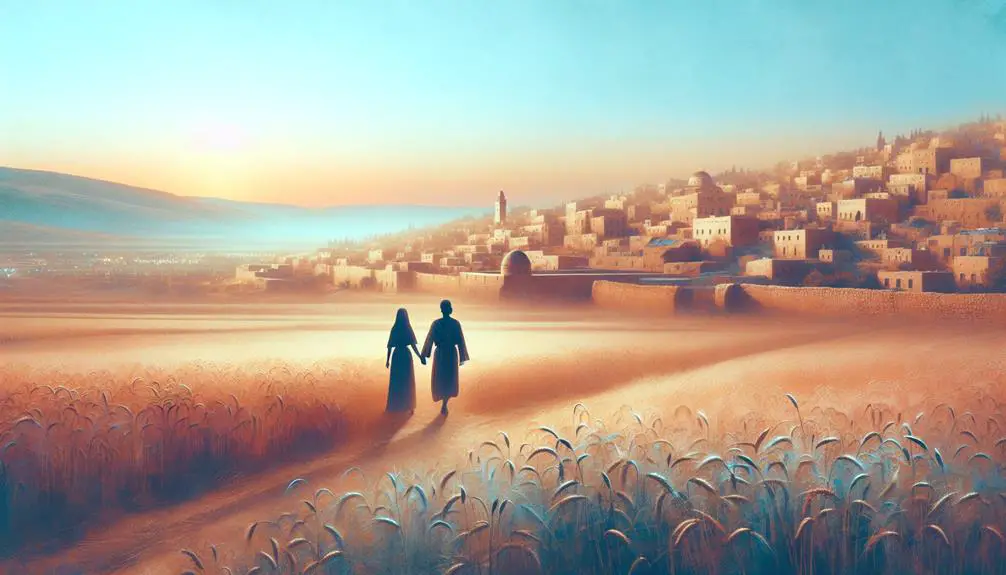
What Happened to Ruth's Husband in the Bible
Like a leaf caught in a fierce autumn wind, Mahlon's life in the Bible was abruptly cut short, leaving behind a tale that intertwines tragedy, loyalty, and love. You've probably heard of Ruth's unwavering devotion to Naomi, but have you ever paused to ponder the fate of her husband, Mahlon?
His demise in the land of Moab marks a pivotal moment, not just for Ruth, but for a lineage that shapes the very foundation of biblical history. To fully grasp the significance of his passing and its aftermath, one must explore the depths of this story, where grief and devotion pave the way to an unexpected legacy.
Key Takeaways
- Ruth's husband, Mahlon, died early in their marriage, leaving her vulnerable and widowed.
- Mahlon's death prompted Ruth's unwavering loyalty to her mother-in-law, Naomi.
- The passing of Mahlon facilitated Ruth's pivotal move from Moab to Bethlehem.
- Mahlon's death indirectly led to Ruth's remarriage to Boaz, securing her place in biblical history.
The Setting in Moab

In the biblical narrative, the land of Moab serves as a crucial backdrop, where Naomi, her husband Elimelech, and their two sons, including Ruth's future husband, sought refuge during a severe famine in Bethlehem. This setting isn't just a geographical shift but a plunge into a society rich in Moabite customs and religious differences, starkly contrasting their Judean origins. Understanding these elements is key to grasping the depth of Ruth's eventual loyalty and the cultural hurdles she overcomes.
Moabite customs were deeply entrenched in the daily lives of its people, influencing their social structures, marital practices, and religious observances. As Naomi's family integrated into this society, these customs would have been impossible to ignore, challenging their traditional Judean beliefs and practices. The Moabites worshipped a pantheon of gods, with Chemosh being the chief deity, a significant religious difference from the monotheistic faith of Naomi's family. This divergence in religious beliefs couldn't have been more pronounced, setting the stage for a complex interplay of cultural and spiritual negotiation.
The immersion into Moabite life meant that Naomi's family was exposed to these religious practices, possibly participating in them to some extent as a means of assimilation or survival. This context is essential in understanding the magnitude of Ruth's decision to cling to Naomi and her God, leaving behind her familiar customs and religious practices. Ruth's journey isn't just a physical return to Bethlehem but a profound spiritual and cultural transition, showcasing her resilience and commitment amidst a backdrop of stark religious differences and Moabite customs.
Mahlon's Family Background
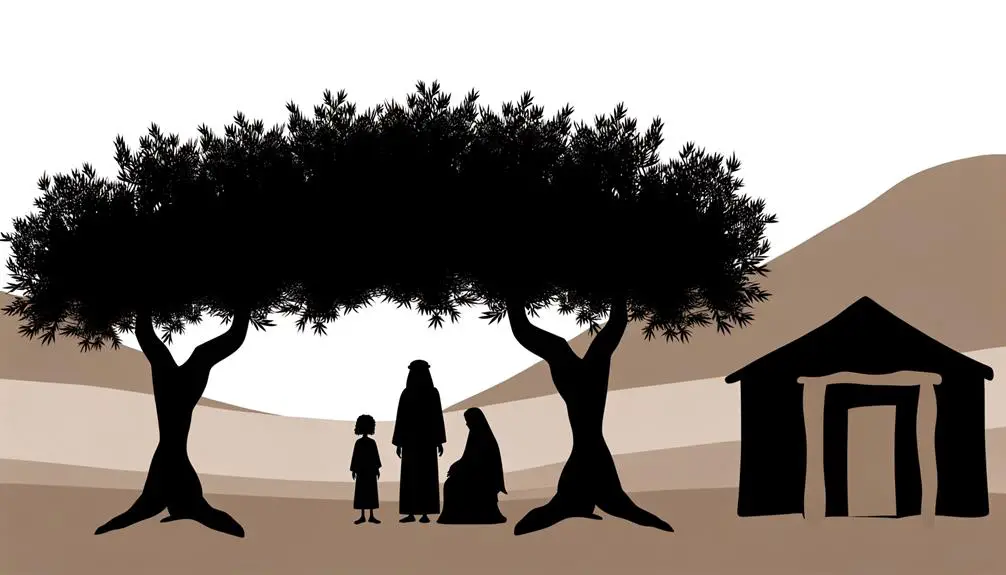
You'll find that Mahlon's roots are deeply entwined in the fabric of Israel's narrative, being the son of Elimelech and Naomi. This connection situates him within a family that faced profound challenges, including famine and migration to Moab.
Understanding Elimelech's lineage and Naomi's immediate family offers significant insights into the broader context of Ruth's story and the socio-religious dynamics of their time.
Elimelech's Lineage
Elimelech, a man of Bethlehem in Judah, fathered two sons, Mahlon and Chilion, establishing a lineage that played a pivotal role in the biblical narrative of Ruth. His character, often depicted through his decisions and the fate of his family, reflects the complexities of life during a period of famine and migration.
Elimelech's decision to move his family to Moab, seeking sustenance, underscores his protective nature but also sets in motion events that would enhance the genealogical significance of his lineage. This move, while initially driven by survival, ultimately intertwines his family with the Moabite lineage through Ruth, his daughter-in-law.
It's a testament to the unforeseen ways in which Elimelech's choices contribute to the fulfillment of a divine plan, highlighting the intricate relationship between human agency and divine will in biblical narratives.
Naomi's Immediate Family
Exploring Naomi's immediate family unveils Mahlon's background, a narrative deeply interwoven with themes of loyalty, tragedy, and the enduring strength of familial bonds. Here's a closer look at how cultural traditions and social norms influenced their lives:
- Marriage Customs: Mahlon's marriage to Ruth wasn't just a personal decision but adhered to cultural expectations of forming alliances and ensuring family continuity.
- Land Ownership: The importance of land in securing a family's future and status within society was paramount.
- Inheritance Rights: Mahlon's potential inheritance highlights the social norms dictating property and lineage continuation.
- Familial Loyalty: Their story exemplifies the depth of loyalty expected within families, transcending individual desires for the collective good.
Understanding these aspects sheds light on the complexities of Naomi's immediate family within their historical and cultural context.
The Famine in Bethlehem
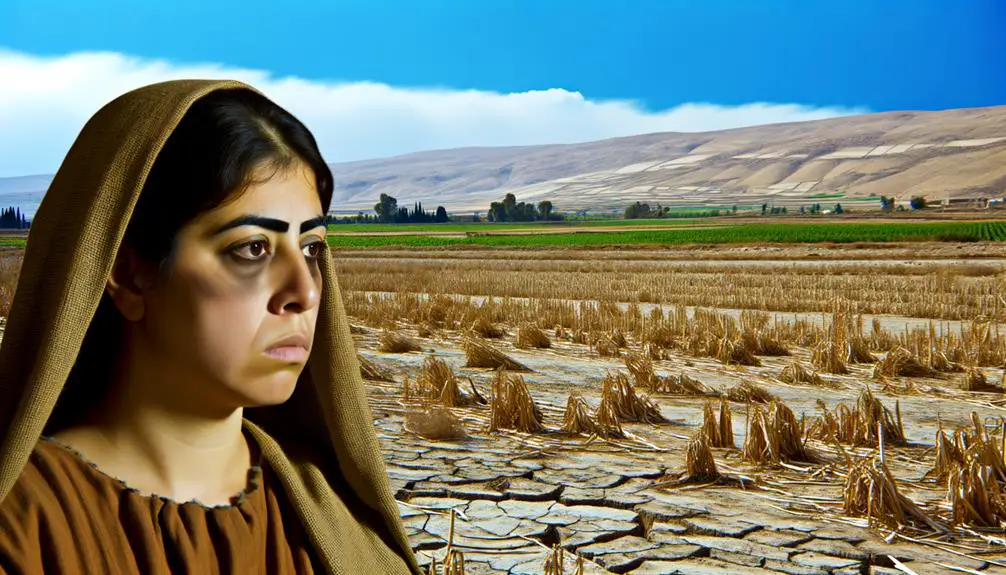
You'll find that the famine in Bethlehem was a pivotal event, not just for Elimelech's family, but for the entire narrative of Ruth.
This scarcity of food, caused by a combination of environmental and possibly socio-political factors, forced Elimelech to make the drastic decision to move his family to Moab.
This migration, driven by survival, set the stage for the unfolding of Ruth's story and her eventual place in the lineage of David.
Cause of Bethlehem Famine
The famine in Bethlehem, a critical event leading to the departure of Naomi and her family, resulted from a combination of ecological, agricultural, and possibly divine factors that severely impacted the region's food production and supply. You might wonder, what exactly contributed to this dire situation? Here are a few key reasons:
- Climate change: Shifts in weather patterns likely led to drought conditions, drastically reducing water availability for crops.
- Agricultural practices: Over-farming and poor land management may have depleted soil fertility, further diminishing crop yields.
- Economic factors: Trade disruptions could have exacerbated the food shortage by limiting access to imported goods.
- Social-political issues: Internal strife or external conflicts might've hindered food distribution, compounding the crisis.
Understanding these factors provides insight into the complex interplay that led to Bethlehem's famine.
Impact on Elimelech's Family
Elimelech's family faced devastating consequences as Bethlehem's famine severely disrupted their livelihood and ultimately compelled them to migrate to Moab in search of sustenance. This period wasn't just a test of physical endurance but also of spiritual faith and adherence to cultural norms. Here's how the famine impacted them:
Impact |
Explanation |
|---|---|
Economic Strain |
Loss of crops and livestock led to financial hardship. |
Social Displacement |
Moving to Moab meant leaving behind their community and cultural practices. |
Spiritual Test |
The famine challenged their faith in God's provision and protection. |
Cultural Shift |
Adapting to Moab's customs likely conflicted with their own cultural identity and values. |
You'll see that the famine's reach extended beyond mere hunger, deeply affecting Elimelech's family's spiritual beliefs and cultural identity.
Migration to Moab
Faced with a severe famine in Bethlehem, Elimelech and his family made the critical decision to migrate to Moab, seeking relief from the economic and social hardships plaguing their lives. This move wasn't just about survival; it had deep cultural implications and was based on strong economic reasons.
- Survival: The famine made sustaining life in Bethlehem nearly impossible.
- Economic Stability: Moab offered the prospect of work and food security.
- Cultural Implications: Moving to Moab meant adapting to a new cultural and religious landscape.
- Family Preservation: Elimelech's priority was safeguarding his family's future.
Analyzing this migration, it's clear that the decision was heavily influenced by the need for economic stability, alongside a willingness to navigate significant cultural shifts for the wellbeing of Elimelech's family.
Migration to Moab
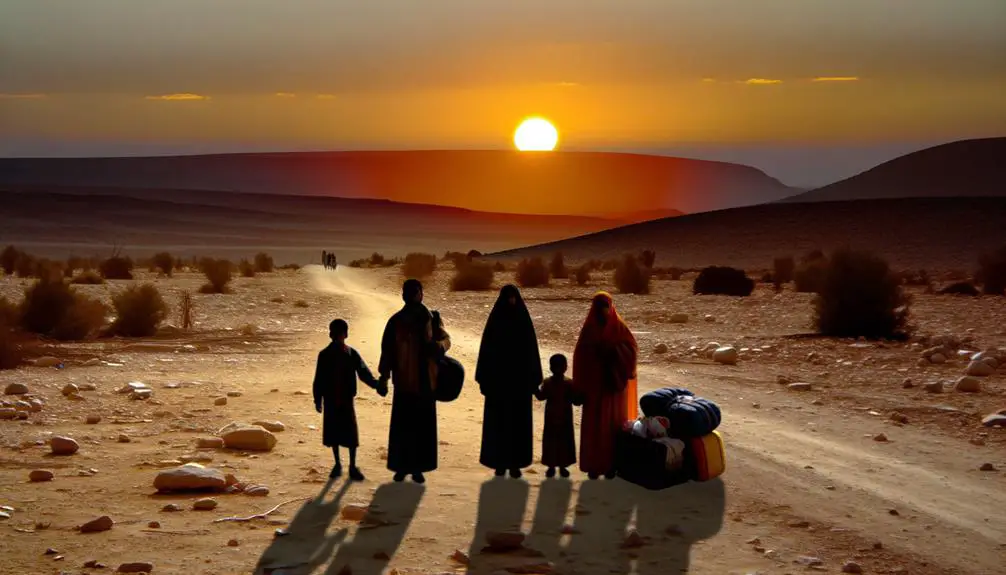
Driven by famine in Bethlehem, Ruth's future husband, along with his family, sought refuge in the land of Moab, initiating a significant chapter in their lives. This migration wasn't a simple relocation but a strategic move influenced by economic motivations and the need for survival. Moab, being a neighboring region, offered prospects of sustenance and stability that Bethlehem could not provide at the time. The decision to move was driven by the dire circumstances back home, highlighting the lengths to which individuals would go to ensure the well-being of their loved ones.
The transition into Moab required an understanding and adaptation to Moabite customs, which were distinct from those in Bethlehem. This adaptation was crucial for integration and acceptance in a foreign land. Economic motivations played a significant role in this migration. The family sought not just refuge but a chance to rebuild their lives in a place where opportunities seemed more abundant.
Aspect |
Bethlehem |
Moab |
|---|---|---|
Economic Situation |
Famine-stricken |
Relatively stable |
Customs |
Israelite traditions |
Moabite rituals |
Motivation for Migration |
Survival |
Economic opportunity |
This table juxtaposes the key differences between Bethlehem and Moab, shedding light on the reasons behind the migration. The move to Moab wasn't merely a change of scenery but a complex decision influenced by economic, cultural, and survival factors. Through this migration, Ruth's future husband and his family embarked on a journey of adaptation, facing the challenges of integrating into a new society while trying to preserve their identity and traditions. This period was a testament to their resilience and determination to find a better life, setting the stage for the extraordinary events that would unfold in Ruth's life.
Mahlon and Ruth's Marriage
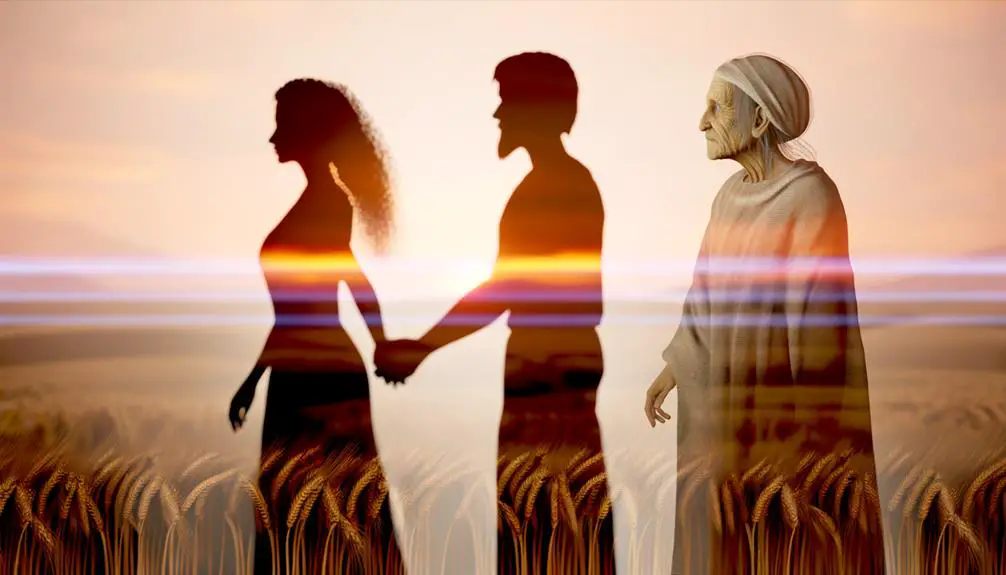
Amidst their efforts to adapt and thrive in Moab, Ruth's marriage to Mahlon emerges as a pivotal moment, intertwining destinies and cultures in profound ways. This union, marked by love and commitment, also serves as a fascinating case study of cultural integration and adaptation. As you delve deeper, you'll discover how their marriage reflects broader themes of identity, loyalty, and resilience.
Here are key aspects of Mahlon and Ruth's marriage that highlight its significance:
- Cross-cultural Union: Their marriage was a blend of Hebrew and Moabite cultures, embodying a significant cross-cultural exchange. This union likely necessitated adjustments and compromises, showcasing the couple's dedication to one another amidst prevailing cultural differences.
- Marriage Customs: The customs surrounding their marriage would have been influenced by both Hebrew and Moabite traditions. Understanding these practices offers insights into how they navigated their identities and obligations within their familial and societal contexts.
- Symbol of Loyalty: Ruth's decision to marry Mahlon and later follow Naomi back to Bethlehem exemplifies her loyalty and love, not just for Mahlon but for his family and faith. This act of devotion becomes a central theme in their narrative, underscoring the strength of familial bonds across cultural divides.
- Integration Challenges: Their marriage likely faced challenges from both within and outside their communities. These obstacles tested their commitment but also highlighted the potential for unity and understanding across differing backgrounds.
Analyzing Mahlon and Ruth's marriage reveals much about the complexities of navigating cultural differences and marriage customs in ancient times. Their story is a testament to the power of love and loyalty to bridge divides, offering timeless lessons on the importance of empathy and open-mindedness in fostering connections.
The Death of Mahlon
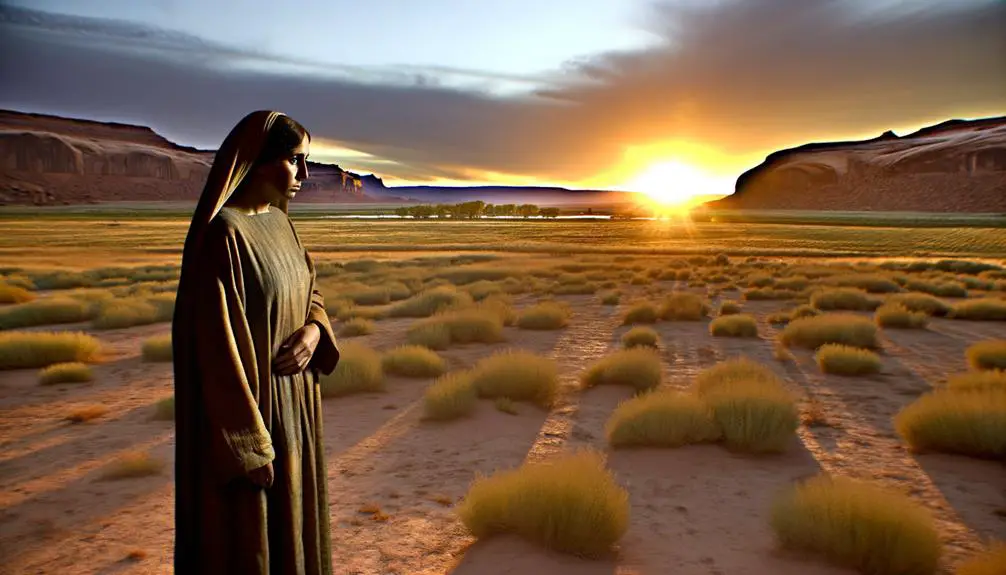
While exploring the depth of Mahlon and Ruth's marriage, it's critical to address the profound impact of Mahlon's death on their intertwined destinies. Mahlon's character, though not extensively detailed in the biblical narrative, plays a pivotal role in the unfolding events that follow his demise. He's remembered as Ruth's Moabite husband, whose death marks a turning point not only in Ruth's life but also in the lineage leading to King David.
Mahlon's death, occurring in a foreign land, underscores the vulnerability and uncertainty faced by Naomi's family, having left Bethlehem due to famine. This event plunges Ruth into widowhood, a status fraught with economic and social challenges, particularly in the cultural norms of the time.
Aspect |
Impact |
Cultural Norms |
|---|---|---|
Economic Security |
Mahlon's death left Ruth without a provider, highlighting the precarious position of widows. |
Widows relied heavily on male relatives for support. |
Social Status |
As a widow and a foreigner, Ruth's social standing was doubly compromised. |
Widows were marginalized, and foreigners faced suspicion. |
Family Lineage |
Mahlon's death threatened the continuation of Naomi's family line. |
Levirate marriage was a practice to preserve family lineage. |
Cultural Integration |
Ruth's decision to stay with Naomi post-Mahlon's death illustrates the complexities of cultural integration. |
Loyalty to one's family was esteemed, yet Ruth's choice defied expectations. |
Understanding Mahlon's character and the cultural backdrop helps illuminate the gravity of his death. It wasn't merely a personal loss for Ruth but a catalyst for her extraordinary journey of loyalty, love, and legacy within a framework of prevailing cultural norms.
Ruth's Devotion to Naomi
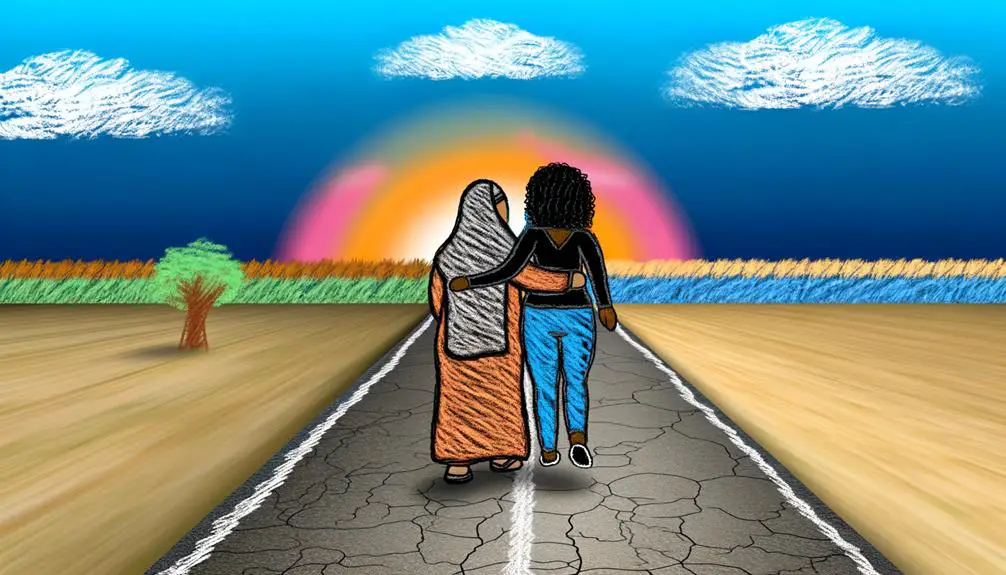
In the wake of Mahlon's death, Ruth's unwavering commitment to Naomi emerges as a profound testament to her character, reshaping their destinies within the narrative. Her decision to stay with Naomi, refusing to return to her Moabite family, highlights Ruth's loyalty and sets the stage for her cultural adaptation in a foreign land. This choice isn't just about familial duty but a deliberate step towards a shared future, redefining the concept of loyalty and belonging.
Ruth's devotion to Naomi is multifaceted, involving:
- Relocation: Ruth chooses to leave her homeland, demonstrating her willingness to face uncertainty for Naomi's sake.
- Support: She takes on the role of provider, gleaning in the fields to sustain them both.
- Adaptation: Ruth navigates a new cultural landscape, learning the customs and laws of Naomi's people.
- Protection: Her actions ensure Naomi's security and well-being, reflecting a deep sense of responsibility.
Ruth's loyalty transcends mere companionship; it signifies a profound bond forged through shared adversity. Her cultural adaptation is equally significant, showcasing her resilience and ability to thrive in unfamiliar environments. Ruth's integration into Naomi's community isn't just a survival strategy but a deliberate effort to honor her commitment to Naomi, illustrating the depth of her character.
Understanding Ruth's devotion and adaptation sheds light on her remarkable journey from a foreign widow to a respected member of Naomi's community. It's a narrative of unwavering loyalty, cultural bridging, and the transformative power of steadfast love and dedication.
Legacy Through Boaz
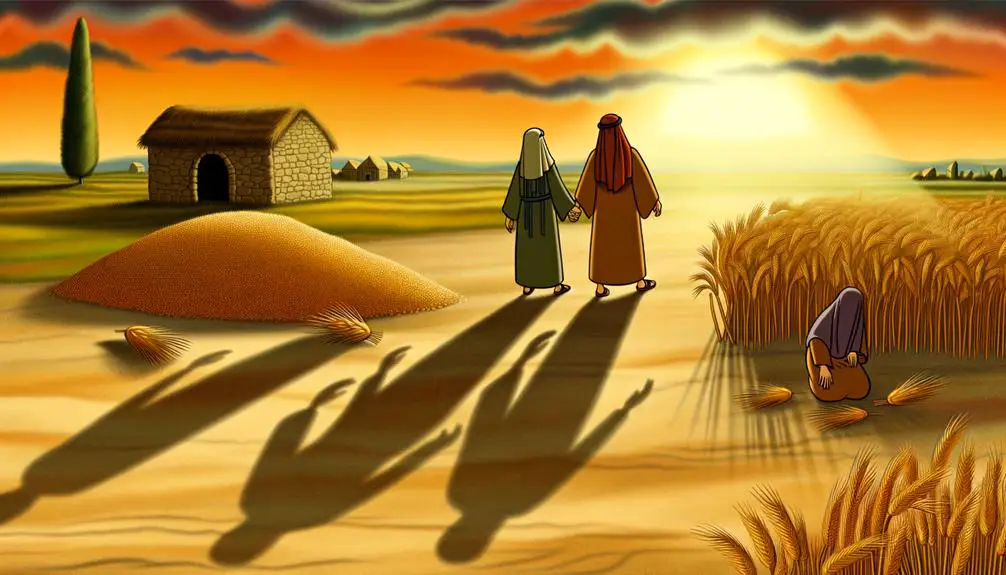
Ruth's encounter with Boaz significantly impacts her legacy, marking a pivotal turn in her story that intertwines her fate with the lineage of significant biblical figures. Delving into Boaz's heritage, it's clear that he's not just a wealthy landowner but also a man of great significance in the Jewish tradition. His lineage, as revealed, links directly to Perez, the son of Judah, positioning Boaz within the tribe of Judah, from which King David and, by extension, Jesus Christ are descended.
Understanding Marital customs of the time brings to light the significance of Ruth's marriage to Boaz. Leveraging the practice of levirate marriage, where a man is obliged to marry his deceased brother's widow to maintain the family lineage, Ruth's union with Boaz wasn't just fortuitous but divinely orchestrated. However, it's Boaz's willingness to go beyond the call of duty, recognizing Ruth's loyalty to Naomi and her embrace of the Jewish faith, that sets this story apart.
This marriage does more than secure Ruth's future; it cements her place in biblical history. Through Boaz's heritage and the couple's adherence to Marital customs, Ruth becomes the great-grandmother of King David, embedding her story within the fabric of Israel's history and the genealogy of Jesus Christ. Thus, your understanding of Ruth's legacy through Boaz offers a profound insight into the interconnectedness of faith, loyalty, and divine providence in the biblical narrative.
Frequently Asked Questions
How Did the Cultural Differences Between Ruth, a Moabite, and Her Israelite Husband Mahlon Impact Their Marriage?
You're diving into how the cultural differences, specifically Moabite customs and Israelite marriage rituals, influenced Ruth and Mahlon's union.
These differences could've posed challenges in their marriage, requiring them to navigate and blend their diverse backgrounds.
By understanding and respecting each other's customs, they likely found common ground.
Their experience underscores the importance of cultural sensitivity and adaptability in marriages, especially those bridging distinct traditions and beliefs.
Are There Any Rabbinic or Midrashic Interpretations That Shed Light on Mahlon's Character or His Life Before Marrying Ruth?
Diving into rabbinic and midrashic texts, you'll find fascinating insights on Mahlon's virtues and his ancestral lineage. These ancient interpretations paint him in a complex light, highlighting his moral and spiritual qualities.
They delve deep, connecting his character to his forebears, offering a rich, nuanced view of his life before marrying Ruth. This analytical journey not only enriches your understanding of Mahlon but also brings ancient wisdom to life.
How Is Mahlon's Death Understood or Interpreted in Different Christian Denominations?
You'll find that Mahlon's death carries varied symbolism across Christian denominations. Some see it as divine punishment, while others view it as a pivotal event leading to the Davidic lineage through Ruth.
Denominational views diverge further on its theological implications, ranging from discussions on faithfulness in adversity to predestined divine plans. Each interpretation deeply analyzes the text, offering a rich tapestry of understanding about life, loss, and providence.
What Are the Archaeological or Historical Evidences, if Any, That Support the Existence of Mahlon or the Events Surrounding His Life and Death?
Diving into the quest for truth, you're seeking archaeological or historical evidence for Mahlon's existence. Unfortunately, concrete evidence eludes us; archaeological methodologies and historical verification haven't yet uncovered definitive proof of his life or the narratives surrounding his demise.
This absence isn't unusual in ancient histories, where the line between myth and fact often blurs. Your analytical eye realizes the challenge in separating biblical stories from historical certainties, underscoring the complexity of ancient evidence.
In Modern Interpretations of the Book of Ruth, How Is Mahlon's Role and Contribution to the Narrative Analyzed or Reimagined?
In modern analyses, Mahlon's role in Ruth's story is nuanced, focusing on his narrative significance and theological implications.
You'll find scholars reimagining his contribution beyond his death, exploring how it sets the stage for Ruth's journey and loyalty, which are pivotal in the biblical narrative.
They delve into how Mahlon's role underscores themes of redemption and providence, offering a deeper understanding of the text's rich layers and its impact on Ruth's life path.
Conclusion
In the tapestry of biblical narratives, Ruth's unwavering devotion to Naomi emerges as a golden thread, illuminated further by the sorrow of Mahlon's death. You've journeyed through the famine-stricken land of Bethlehem to the uncertain refuge of Moab, witnessed the bittersweet union of Mahlon and Ruth, and felt the sharp pang of loss as Mahlon's life ebbed away.
Yet, it's through this crucible of grief that Ruth's loyalty shines, eventually weaving her into the lineage of kings. Analyzing this story reveals the resilience embedded in devotion, a testament to the strength found in the bonds we choose to uphold.

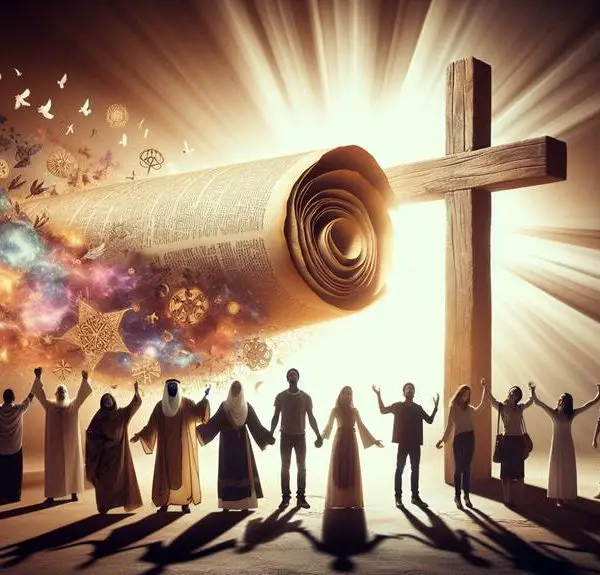
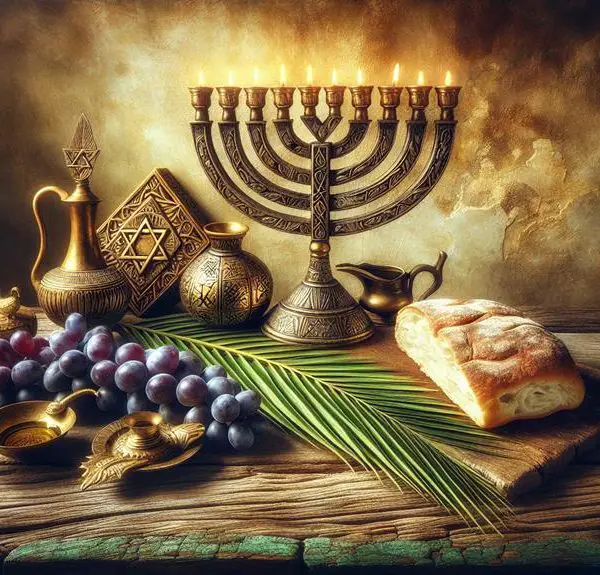
Sign up